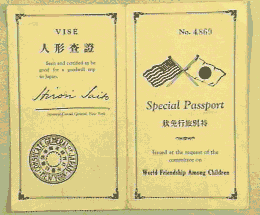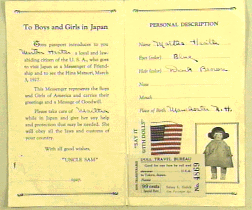Pretty Porcelain Dolls
|
|
Miss Toyama is on a mission of goodwill to the United States that started in 1929. Her story has drama, tragedy, and joy: It's a tale worth hearing. In 1926, an American missionary named the Rev. Sidney Lewis Gulick began to worry about the fact that the American and Japanese governments were not getting along. Dr. Gulick had spent 25 years in Japan and had learned Japanese. He felt he knew the Japanese people well and wanted to do something to try to prevent a war. He had an idea. He would send some unusual goodwill ambassadors to Japan. He started the Committee on World Friendship among Children and began collecting dolls from children around the United States. After about a year, the Friendship Doll Project had gathered 12,739 dolls. These blue-eyed dolls (all different kinds) were sent to Japanese schools in time for the annual doll festival called Hina Matsuri that falls each year on Girls Festival, March 3.
The Japanese children were delighted. In response, they sent 58 handmade dolls to America -- to the 48 states plus 10 more to the biggest states. The dolls arrived in time for Christmas and were unusually tall -- 32 inches high. They each carried the name of the prefecture (regional district) from which they came and were decked out in traditional 17th century finery.
Miss Toyama came to Louisville, Kentucky, from the Toyama prefecture. She was in her own trunk with all her accessories neatly packed around her. She had a parasol and two pairs of sandals, and other objects that helped American children learn about Japanese culture, just as the blue-eyed dolls brought American culture to Japan. She was put on display at the J.B. Speed Art Museum for everyone to see. But in 1937 a great flood swept through Louisville, and the museum was badly damaged. Many works of art were also damaged or lost. Miss Toyama disappeared and many thought she had been swept away. For more than 50 years, no one knew what had happened to her. World War II came and went. Then in 1992, she was rediscovered in her trunk, needing a lot of repair. To be properly fixed, she was sent back to Japan for what museum workers call "conservation." Now she is back in America, good as new, to remind everyone why she was made. Of her 57 sister dolls, 30 are known to have survived. Many of them have been conserved and restored to places of honor. Dolls are well-loved toys in many nations. But in Japan even adults collect dolls, and boys as well as girls find them fascinating. In fact, for hundreds of years, dolls were not thought of as playthings at all in Japan. They were more like sculptures. Dressed in beautiful costumes with lots of tiny details and real hair on their carefully formed heads, these dolls might represent samurai warriors (Japanese knights), court ladies, or royal lords. In wealthy homes, the dolls were taken out for display only on Girls Festival (March 3) or Boys Festival (May 5). Children were allowed to look at them -- but not to touch. Then the dolls were stored for another year. Many people believed that the dolls had a kind of life of their own -- not quite human, of course. But feelings and thoughts are attributed to them, which may help explain the letters modern Japanese children sent recently to America. After she was repaired, Miss Toyama was displayed in Japan in all her glory, along with several of the blue-eyed dolls that had survived World War II. |
 The dolls were dressed beautifully and each carried a message: "May the
United States of America and Japan always stay friends. I am being sent to Japan
on a mission of friendship. Please let me join the doll festival." The
dolls also carried passports. They said, "This doll is a good citizen of
the United States of America. She will obey all the laws and customs of your
country. Please take care of her while she is with you."
The dolls were dressed beautifully and each carried a message: "May the
United States of America and Japan always stay friends. I am being sent to Japan
on a mission of friendship. Please let me join the doll festival." The
dolls also carried passports. They said, "This doll is a good citizen of
the United States of America. She will obey all the laws and customs of your
country. Please take care of her while she is with you."